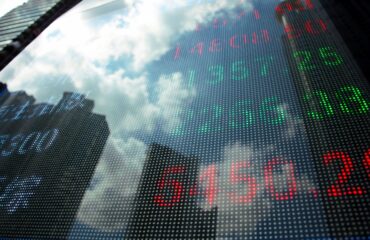In a financial world often swayed by the merest whisper of policy change, this beginning of the week’s market movements have been a testament to the enduring strength of the American economy—a strength that appears to be holding its own against the persistent winds of monetary policy.
The market is a much like a historical novel, unfurling in real-time. The latest chapter has seen yields on Treasury notes ascend with a certain stoicism, as traders scale back their bets on the Federal Reserve’s easing. The 10-year yields, marching up to 4.16%, are less a reaction to the present moment and more an acknowledgement of the economic path laid out by enduring growth and inflation’s stubborn presence.
We should be reminded that such economic indicators are part of a grander machine, one that operates on the fuel of productivity, employment data, and consumer demand. The ISM services gauge striking a four-month high, and the uptick in prices it heralded, are but cogwheels in this mechanism, suggesting not only resilience but also the potential for inflationary pressure that may keep the Fed’s hand steady on the tiller for longer than market optimists had hoped.
The market’s reaction has been as cerebral as it has been visceral. The dollar, finding newfound vigor, reached its zenith since November, perhaps as a nod to the robustness of U.S. financial conditions compared to its G-10 counterparts. The S&P 500, after a dalliance with lower levels, recovered as Nvidia led a revival in the chipmaker’s fortunes. It’s a nuanced market response that speaks to underlying strength, even as it grapples with the reality of a less accommodative Fed.
Those of us with a keen sense of economic principles, might view the tightening of bank credit standards, as reported in the Senior Loan Officer Opinion Survey, as a sign not of contraction but of a prudent recalibration—a necessary adjustment to align with a market that is far from capitulating to the pessimists’ chorus.
And yet, amidst this stoic narrative, there is the undercurrent of uncertainty that Grant so often alludes to. The inversion of the interest-rate curve, as discussed recently by Bill Gross, looms in the background, a harbinger of economic transitions yet to come. It’s a reminder that while the market’s plot may currently be one of resilience, the next turn of the page is never quite predictable.
This week’s events—ranging from corporate earnings surprises to Powell’s reaffirmation of a March rate hold—have been chapters of their own in this unfolding story. The market has been a reader as much as a participant, absorbing the impact of the ISM figures, the Fed’s rhetoric, and the strength of the dollar, all while preparing for the next narrative twist.
As we pen this latest entry in the financial annals, we find a market that is robust yet reflective, confident yet cautious. It is a market that understands the gravity of economic indicators, the weight of Fed policy, and the ever-present specter of future uncertainty. As investors turn the page, they do so with a watchful eye, aware that the story of 2024 is far from over, and the next chapter is yet to be written.
In the upcoming week, the financial calendar teems with pivotal events that promise to sway the markets further. The Reserve Bank of Australia will cast its decision on interest rates, setting the tone for the week as markets gauge the global monetary policy landscape. Eurozone retail sales and German factory orders, both slated for Tuesday, will offer fresh insights into the health of European commerce amidst global economic recalibration.
UBS will lay bare its earnings, providing a bellwether for the financial sector’s robustness, while central bank voices from Canada and the U.S. are expected to contribute their tenor to the symphony of economic discourse. Midweek brings us Germany’s industrial production data and Walt Disney’s earnings, each with the potential to ripple through market sentiments.
China’s inflation figures will come under scrutiny, with implications for commodity and global supply chains, while the U.S. wholesale inventories and jobless claims will be measured for domestic economic momentum. Janet Yellen’s address to the Senate banking committee may offer critical insights into financial oversight and stability considerations.
The latter part of the week will not lack for drama, with the European Central Bank’s economic bulletin and keynotes from its chief economist, alongside U.S. CPI revisions that may influence Fed policy expectations. The interplay of politics and economics will be personified as President Biden meets with German Chancellor Scholz, against a backdrop of a shifting geopolitical landscape.
Reflecting on the market movements, we’ve witnessed modest retreats in the S&P 500, Nasdaq, and Dow Jones Industrial Average, hinting at the market’s digestion of recent and upcoming stimuli. The currency market has seen the dollar strengthen, the euro and pound weaken, and the yen slip marginally, illustrating the complex web of currency dynamics at play.
Cryptocurrencies, too, have not been immune to the week’s tremors, with Bitcoin and Ether both registering declines. Bond yields, notably the U.S. 10-year Treasury, have advanced, echoing the shift in investor sentiment towards expectations of a persisting robust economy.
The commodities market has been a mixed bag, with West Texas Intermediate crude nudging upward, even as spot gold has dipped, underscoring the divergent paths of energy and safe-haven assets.
As we stand on the cusp of this week’s economic revelations, the markets seem to hold their breath, poised for the next cascade of data and dialogue that will shape the contours of global finance.
Joint Market Analysis:
As the week unfurls a tapestry of economic events, investors find themselves navigating a marketplace that is as dynamic as it is unpredictable. The Reserve Bank of Australia’s upcoming rate decision and the cascade of economic data from the Eurozone to China are but a prelude to the symphony of global monetary policy cues and market reactions.
One might consider these events as historical markers, points in time that will be looked back upon as either the harbingers of economic stability or the missed signals of a market correction. We at Capital Currents would caution against the heady optimism that can often precede a fall, noting that while the market has exhibited a remarkable resilience, the foundations upon which it rests—interest rates, inflation, and corporate earnings—are shifting.
That being said, we would also remind our readers of the “machine” that is the global economy. Each rate decision, each earnings report, is a cog in this machine, influencing the next and driven by the previous. The Reserve Bank of Australia’s choices, UBS’s financial health, and the words of central bankers from Canada to the European Central Bank collectively shape the environment in which markets operate.
Today’s slight retreat in stock indices could be seen as the market’s momentary pause, a collective intake of breath before the plunge into the known and unknown variables of economic indicators and fiscal policy. The currency movements—with the strengthening dollar and retreating euro and pound—speak to the shifts in investor confidence and the search for safe havens in a world where certainty is the most valuable commodity.
We should also not the importance of the bond market’s reaction, with Treasury yields advancing as a testament to the market’s evolving expectations for economic growth and inflation, a subtle acknowledgment that the era of ultra-low interest rates is reaching its twilight.
The commodities market, with its rise in crude oil and decline in gold prices, presents a dichotomy that would read as a narrative of an economy still in motion, fueled by energy demands and yet casting a wary eye on the gold’s luster as a hedge against uncertainty.
In summary, the week ahead is a chapter yet to be written, a story whose characters—central banks, multinational corporations, commodities, and currencies—are familiar, but whose plot is ever-original. The markets, in their collective wisdom and folly, await the unfolding of these events, ready to interpret and react to the staccato rhythm of economic life.



